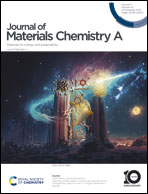Morphology and cell performance of poly(fluorene)-based anion exchange membranes for water electrolysis: effect of backbone core structure†
Abstract
For the satisfactory ionic conductivity of anion exchange membranes (AEMs), it is crucial to develop a membrane with a precisely manipulated morphology. Here, we report AEM morphology changes according to core structure in novel aryl ether-free poly(fluorene) AEMs with alkyl spacers on biphenyl, fluorene, and spirobifluorene polymer backbones constructed via the Suzuki cross-coupling reaction. Morphological and conformational analyses of these AEMs were undertaken using small-angle X-ray scattering (SAXS) and grazing-incidence wide-angle X-ray scattering (GIWAXS). As a result, PFPB-QA, which had the lowest glass transition temperature due to the limited rotation of biphenyl, exhibited the most oriented structure and well-connected ion transport channels, thereby exhibiting high conductivity (>125 mS cm−1 at 80 °C) and high alkaline stability (>96% in 1 M KOH at 80 °C). Moreover, a PFPB-QA water electrolysis cell showed a cell performance of 2.68 A cm−2 at 2.0 V and a degradation rate of 1.07% during a 500 h durability test at 70 °C in 1 M KOH.

- This article is part of the themed collection: Journal of Materials Chemistry A HOT Papers


 Please wait while we load your content...
Please wait while we load your content...